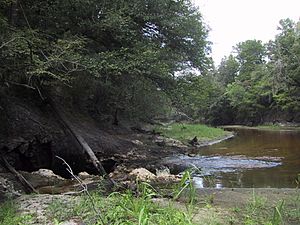Surface water facts for kids

Surface water is all the water found on top of the Earth's land. This includes water in rivers, lakes, wetlands, and oceans. It is different from groundwater, which is water stored underground in the soil and rocks. It's also different from atmospheric water, which is water vapor in the sky.
Contents
What is Surface Water?
Surface water is a very important part of our planet. It covers about 71% of the Earth's surface. Most of this is salt water found in oceans. The rest is fresh water, which is vital for plants, animals, and humans.
Types of Surface Water
There are two main types of surface water:
- Salt water: This is found in oceans and seas. It has a lot of salt dissolved in it.
- Fresh water: This is found in rivers, lakes, and ponds. It has very little salt. Most living things need fresh water to survive.
Where Does Fresh Surface Water Come From?
Fresh surface water is always being refilled. This happens mainly in two ways:
- Precipitation: When it rains or snows, water falls from the sky. This water flows into rivers and lakes.
- Groundwater: Sometimes, water from underground (groundwater) can flow up to the surface. This adds to rivers and lakes.
Where Does Surface Water Go?
Surface water doesn't stay in one place forever. It moves and changes forms. Here's how it can leave a surface water body:
- Evaporation: The sun's heat turns water into vapor. This vapor rises into the air, becoming atmospheric water.
- Seepage: Water can soak into the ground. When this happens, it becomes groundwater.
- Use by living things: Plants use water for transpiration. Animals and humans drink it. People also use it for agriculture, washing, and other daily needs.
- Discharge to the ocean: Rivers flow into the ocean. When fresh water reaches the ocean, it mixes with salt water.
Related Pages
Images for kids
See also
 In Spanish: Agua superficial para niños
In Spanish: Agua superficial para niños



